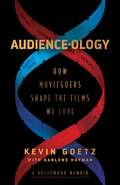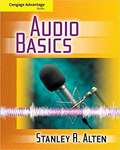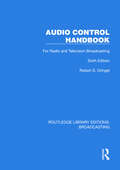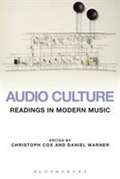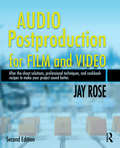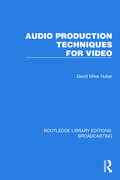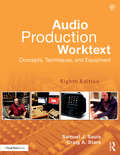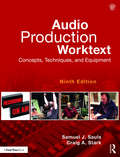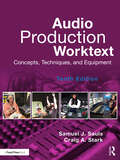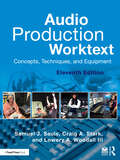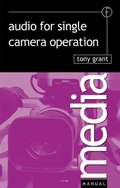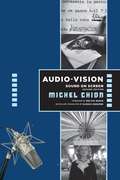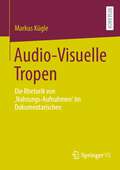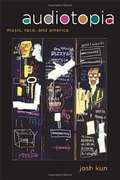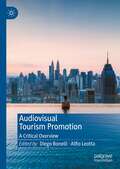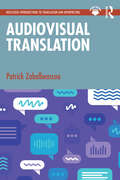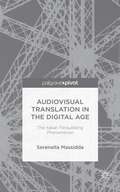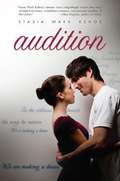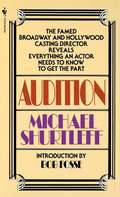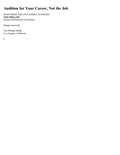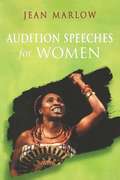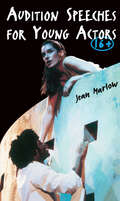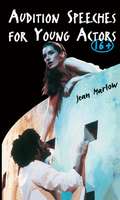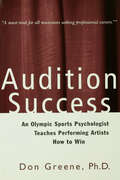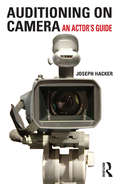- Table View
- List View
Audience-ology: How Moviegoers Shape the Films We Love
by Kevin GoetzDiscover the fascinating and secretive process of audience testing of Hollywood movies through these first-hand stories from famous filmmakers, studio heads, and stars.Audience-ology takes you to one of the most unknown places in Hollywood—a place where famous directors are reduced to tears and multi-millionaire actors to fits of rage. A place where dreams are made and fortunes are lost. This book is the chronicle of how real people have written and rewritten America&’s cinematic masterpieces by showing up, watching a rough cut of a new film, and giving their unfettered opinions so that directors and studios can salvage their blunders, or better yet, turn their movies into all-time classics. Each chapter informs an aspect or two of the test-screening process and then, through behind-the-scenes stories, illustrates how that particular aspect was carried out. Nicknamed &“the doctor of audience-ology,&” Kevin Goetz shares how he helped filmmakers and movie execs confront the misses and how he recommended ways to fix the blockbusters, as well as first-hand accounts from Ron Howard, Cameron Crowe, Ed Zwick, Renny Harlin, Jason Blum, and other Hollywood luminaries who brought you such films as La La Land, Chicago, Titanic, Wedding Crashers, Jaws, and Forrest Gump. Audience-ology explores one of the most important (and most underrated) steps in the filmmaking process with enough humor, drama, and surprise to entertain those with only a spectator&’s interest in film, offering us a new look at movie history.
Audio Basics
by Stanley AltenWritten by highly respected author Stan Alten, AUDIO BASICS provides readers with a fundamental understanding of the principles, technology, and techniques of audio production. Because the material is not medium-specific, readers can apply techniques to sound production in any of the major audio and audio/visual media.
Audio Control Handbook: For Radio and Television Broadcasting (Routledge Library Editions: Broadcasting #3)
by Robert S. OringelAudio Control Handbook (1989) employs a step-by-step approach to prepare students for audio work in the broadcast industry, covering real-life principles, tools and procedures. It uses clear, nontechnical language to look at the effective use of standard audio equipment, from basic microphones and control boards to digital signal processors and tape recorders.
Audio Culture: Readings in Modern Music
by Christoph Cox Daniel WarnerThe groundbreaking Audio Culture: Readings in Modern Music maps the aural and discursive terrain of vanguard music today. Rather than offering a history of contemporary music, Audio Culture traces the genealogy of current musical practices and theoretical concerns, drawing lines of connection between recent musical production and earlier moments of sonic experimentation. It aims to foreground the various rewirings of musical composition and performance that have taken place in the past few decades and to provide a critical and theoretical language for this new audio culture. Via writings by philosophers, cultural theorists, and composers, Audio Culture explores the interconnections among such forms as minimalism, indeterminacy, musique concrète, free improvisation, experimental music, avant-rock, dub reggae, Ambient music, HipHop, and Techno. Instead of focusing on the putative "crossover" between "high art" and "popular culture," Audio Culture takes all of these musics as experimental practices on par with, and linked to, one another. While cultural studies has tended to look at music (primarily popular music) from a sociological perspective, the concern here is philosophical, musical, and historical. Audio Culture includes writing by some of the most important musical thinkers of the past half-century, among them John Cage, Brian Eno, Glenn Gould, Umberto Eco, Ornette Coleman, Jacques Attali, Simon Reynolds, Pauline Oliveros, Paul D. Miller, David Toop, John Zorn, Karlheinz Stockhausen, and many others. The book is divided into nine thematically-organized sections, each with its own introduction. Section headings include topics such as "Modes of Listening," "Minimalisms," and "DJ Culture. " In addition, each essay has its own short introduction, helping the reader to place the essay within musical, historical, and conceptual contexts. The book concludes with a glossary, a timeline, and an extensive discography.
Audio Postproduction for Film and Video
by Jay RoseNew to this edition:* Learn how many Hollywood techniques--previously impractical on video--can help solve problems on smaller productions* Expanded cookbook recipes section* Technically updated throughoutMake your soundtracks as good as your pictures with this compendium of professional audio techniques that can be adapted to desktop post. Specializing in sound after the shoot, this book features many practical examples, cookbook recipes, and tutorials. Audio theory, when necessary, is presented in plain English with plenty of visual analogies.FAQs, full explanations, and from-the-trenches tips address the complete range of processes from wiring and hardware to testing the final mix. The downloadable resources features platform-independent diagnostics, demonstrations, and tutorial tracks. Novices will learn how to improve their soundtrack--even after the actors have gone home. Experienced producers will learn how to solve technical and creative problems quickly.You'll get recipes and step-by-step instructions on how to:* build an efficient and reliable audio post setup* plan and budget a good soundtrack* get sound into your NLE without losing quality or sync* edit voices and music* record Foley and ADR* find music and use it effectively* find and create your own sound effects* shape sounds with equalization, reverb, noise reduction, and more* produce the final mix* test the final product for various mediaPlease visit the author's website for additional resources: http://www.dplay.com/book/app2e/
Audio Production Techniques for Video (Routledge Library Editions: Broadcasting #4)
by David Miles HuberAudio Production Techniques for Video (1987) looks at the mechanics and operation of audio tape and video tape recorders; audio and video synchronization-technology; studio and location audio production processes; video and audio post-production; troubleshooting time-code problems.
Audio Production Worktext: Concepts, Techniques, and Equipment
by Samuel J. Sauls Craig A. StarkThis is an excellent introduction to the modern radio production studio, the equipment found in that studio, and the basic techniques needed to accomplish radio production work. The new edition is updated throughout and features new sections on mobile technology, audio editing apps and software, and digital editing, as well as updated graphics and expanded content on portable digital audio players. Features a worktext/website format tailored for both students and teachers, offering a solid foundation for anyone who wishes to know more about radio/audio equipment and production techniques.
Audio Production Worktext: Concepts, Techniques, and Equipment
by Samuel J. Sauls Craig A. StarkAudio Production Worktext, 9th Edition provides readers the best introduction to audio and radio production. It shows how to navigate modern radio production studios and utilize the latest equipment and software. The 9th edition is updated to cover new mobile technologies, digital consoles, and audio editing apps and software, as well sound for the visual media and Internet radio. The new edition continues to include the worktext/website format tailored for both students and teachers and features like Production Tips that provide notes relevant to various audio production topics, self-study questions and projects, an updated Glossary, and an up-to-date companion website with invaluable student and instructor materials. Included in this edition are offers and features from Pro Sound Effects, FilmTVsound.com, and RadioFX, as well as updated color graphics and images throughout the text.
Audio Production Worktext: Concepts, Techniques, and Equipment
by Samuel J. Sauls Craig A. StarkNow in its tenth edition, the Audio Production Worktext offers a comprehensive introduction to audio production in radio, television, and film. This hands-on, student-friendly text demonstrates how to navigate modern radio production studios and utilize the latest equipment and software. Key chapters address production planning, the use of microphones, audio consoles, and sound production for the visual media. The reader is shown the reality of audio production both within the studio and on location. New to this edition is material covering podcasting, including online storage and distribution. The new edition also includes an updated glossary and appendix on analog and original digital applications, as well as self-study questions and projects that students can use to further enhance their learning. The accompanying instructor website has been refreshed and includes an instructor’s manual and PowerPoint images. This book remains an essential text for audio and media production students seeking a thorough introduction to the field.
Audio Production Worktext: Concepts, Techniques, and Equipment
by Samuel J. Sauls Craig A. Stark Lowery A. Woodall IIINow in its eleventh edition, Audio Production Worktext offers a comprehensive introduction to audio production in radio, podcasting, television, and film.This hands-on, student-friendly text demonstrates how to navigate modern radio production studios and utilize the latest equipment and software. Key chapters address production planning, the use of microphones, audio consoles, and sound production for visual media. The reader is shown the reality of audio production both within the studio and on location. In this new edition, chapters have been reorganized to address the growing prominence of podcasting and digital production. Thorough updates have been made to every chapter, including self-study questions and projects, and the authors continue to draw in diverse and international practitioner perspectives to help translate concepts to real-world practice.This book remains an essential text for audio and media production students seeking a thorough introduction to the field.The accompanying website for students and instructors has also been updated and includes sample syllabi, lesson plans, further study questions, test questions, and web resources, as well as images by chapter as included in the Worktext.
Audio for Single Camera Operation
by Tony GrantIn the last decade a greater demand has been placed on cameramen to record sound as well as pictures on location. For anyone wanting to learn about the basics of recording sound, specific to single camera location work this book provides an ideal grounding. It covers the equipment a single operator would use, methods and examples of how to learn sound techniques and ways of successfully working alone. While it offers an account of audio theory, including post-production it also explains the essential audio technology basics. Covering typical techniques including live broadcasting, it teaches practical everyday instruction on what microphones to rig, how to sound balance everyday news, magazine and current affairs etc.Techniques are explained and laid out in an accessible format supported by diagrams and are organised in easy to browse topics for quick reference. The author's approach is clear yet comprehensive, offering real hands-on experience of the skills involved in broadcast audio. This manual is seen as a basic, practical introduction to tackling the problems of recording sound on location as a cameraman, thus providing the necessary experience and knowledge required of everyday operation.
Audio-Vision: Sound On Screen
by Michel ChionMichel Chion’s landmark Audio-Vision has exerted significant influence on our understanding of sound-image relations since its original publication in 1994. Chion argues that sound film qualitatively produces a new form of perception. Sound in audiovisual media does not merely complement images. Instead, the two channels together engage audio-vision, a special mode of perception that transforms both seeing and hearing. We don’t see images and hear sounds separately—we audio-view a trans-sensory whole.In this updated and expanded edition, Chion considers many additional examples from recent world cinema and formulates new questions for the contemporary media environment. He takes into account the evolving role of audio-vision in different theatrical environments, considering its significance for music videos, video art, commercial television, and the internet, as well as conventional cinema. Chion explores how multitrack digital sound enables astonishing detail, extending the space of the action and changing practices of scene construction. He demonstrates that speech is central to film and television and shows why “audio-logo-visual” is a more accurate term than “audiovisual.” Audio-Vision shows us that sound is driving the creation of a sensory cinema.This edition includes a glossary of terms, a chronology of several hundred significant films, and the original foreword by sound designer, editor, and Oscar honoree Walter Murch.
Audio-Visuelle Tropen: Die Rhetorik von ‚Nahrungs-Aufnahmen‘ im Dokumentarischen
by Markus KügleIn diesem Buch werden Dokumentarfilme analysiert, welche prominent die zeitgenössische Ernährung zum Thema haben. Die audiovisuelle Dokumentation wird dabei als Argumentation begriffen, das Zusammenspiel von bestimmten Inszenierungs-Modi in Sachen Bewegtbild und Ton als rhetorische Figuren, genauer als Tropen, welche jeweils bestimmte Persuasionen zu evozieren imstande sind. Frei nach Ansätzen aus dem Bereich der Neuen Rhetorik und der Psychoanalytischen Filmtheorie (u. a. Christian Metz) wird ein Modell, bestehend aus Metonymie, Synekdoche, Metapher, Katachrese und Ironie, entwickelt, um klären zu können, wie ‚Nahrungs-Aufnahmen‘ argumentationstechnisch oder vielmehr sophistisch, wenn nicht gar rabulistisch funktionieren.
Audiotopia: Music, Race, and America
by Josh KunRanging from Los Angeles to Havana to the Bronx to the U.S.-Mexico border and from klezmer to hip hop to Latin rock, this groundbreaking book injects popular music into contemporary debates over American identity. Josh Kun insists that America is not a single chorus of many voices folded into one, but rather various republics of sound that represent multiple stories of racial and ethnic difference. To this end he covers a range of music and listeners to evoke the ways that popular sounds have expanded our idea of American culture and American identity. Artists as diverse as The Weavers, Cafe; Tacuba, Mickey Katz, Rahsaan Roland Kirk, Bessie Smith, and Ozomatli reveal that the song of America is endlessly hybrid, heterogeneous, and enriching--a source of comfort and strength for populations who have been taught that their lives do not matter. Kun melds studies of individual musicians with studies of painters such as Jean-Michel Basquiat and of writers such as Walt Whitman, James Baldwin, and Langston Hughes. There is no history of race in the Americas that is not a history of popular music, Kun claims. Inviting readers to listen closely and critically, Audiotopia forges a new understanding of sound that will stoke debates about music, race, identity, and culture for many years to come.
Audiovisual Tourism Promotion: A Critical Overview
by Alfio Leotta Diego BonelliThis book deploys the concept of ‘audiovisual tourism promotion’ to account for the promotional functions performed by a vast array of diverse media texts including tourism films, feature films, digital videos conceived for online circulation, video games and TV commercials. From this point of view, this volume fills a major gap in the literature by providing the first comprehensive critical overview of audiovisual tourism promotion as a distinct media field. In this book, the study of audiovisual tourism promotion is characterised by an interdisciplinary approach which combines film studies, media studies, human geography, sociology, tourism studies, history, postcolonial and gender studies. This book will appeal to a wide range of students and scholars from different disciplines.
Audiovisual Translation (Routledge Introductions to Translation and Interpreting)
by Patrick ZabalbeascoaThis accessible textbook introduces the core concepts and issues of translation relevant for the training of audiovisual translators.Structured around different characteristics and problem areas in audiovisual translation (AVT), this text provides the scaffolding for shaping informed, critical thinkers and astute translators. Adopting a theory-driven approach, with short theoretical introductions and clear definitions, the author incorporates challenging issues to encourage readers to find their own answers and opinions. Translation technology is explored where relevant and current online resources will be introduced but discussed in a timeless fashion, without focusing on specific software, so that the thinking can be applied to and reconciled with evolving and future platforms, as well as other modes of translation. Each chapter includes an introduction to concepts and issues, explanations and debate, a wide range of examples and exercises and questions throughout. Written by a leading researcher and practising teacher with experience freelancing in the AVT field, this is the ideal core textbook for students on postgraduate courses in AVT and of interest to both practising translators and students in translation studies, multimodal analysis, languages and film studies.
Audiovisual Translation in the Digital Age: The Italian Fansubbing Phenomenon
by Serenella MassiddaThis pioneering study on fan translation focuses on Italian fansubbing as a concept, a vibrant cultural and social phenomenon which is described from its inception in 2005 to today. It explores far-reaching issues related to fansubbing and crowdsourcing, highlighting in particular the benefits and drawbacks of Web 2. 0.
Audition
by Kehoe Stasia WardWhen high school junior Sara wins a coveted scholarship to study ballet, she must sacrifice everything for her new life as a professional dancer-in-training. Living in a strange city with a host family, she's deeply lonely-until she falls into the arms of Remington, a choreographer in his early twenties. At first, she loves being Rem's muse, but as she discovers a surprising passion for writing, she begins to question whether she's chosen the right path. Is Rem using her, or is it the other way around? And is dancing still her dream, or does she need something more? This debut novel in verse is as intense and romantic as it is eloquent. .
Audition
by Michael ShurtleffMichael Shurtleff has been casting director for Broadway shows likeChicago and Becket and for films like The Graduate and Jesus Christ Superstar. His legendary course on auditioning has launched hundreds of successful careers. Now in this book he tells the all-important HOW for all aspiring actors, from the beginning student of acting to the proven talent trying out for that chance-in-a-million role!
Audition For Your Career, Not The Job: Mastering The On-camera Audition
by Stephanie Gunning Tim PhillipsYou’ve got a big audition lined up for a role in a film or on a television series. What do you do now? AUDITION FOR YOUR CAREER, NOT THE JOB covers steps you can take and specific skills you can put to use immediately to feel more confident about your performance in your next audition and make a great and lasting impression on casting directors and producers. If your work is consistently first-rate and memorable, then every on-camera audition is an opportunity to advance your acting career. This book will teach you techniques that improve your ability to read and interpret the sides quickly, helping you to trust your instincts and craft strong, bold, specific acting choices, and setting you up for an active and profitable career.
Audition Speeches for Women (Stage And Costume Ser.)
by Jean MarlowAudition Speeches for Women is an invaluable resource for acting classes, competitions, auditions, and rehearsals, and an affordable and necessary tool for serious actors everywhere.
Audition Speeches for Young Actors 16+: For All Ages And Accents (Audition Speeches Ser.)
by Jean MarlowAudition Speeches for 6-16 Year Olds offers a generous helping of carefully selected speeches that children can prepare for auditions. Each speech is introduced with commentary to set the scene and help the young actor.
Audition Speeches for Younger Actors 16+: For All Ages And Accents (Audition Speeches Ser.)
by Jean MarlowAudition speeches for actors aged 16-18, selected by Jean Marlow. Includes advice from actors, casting directors and teachers
Audition Success (A\theatre Arts Book Ser.)
by Don GreeneAudition Success presents a groundbreaking method that has already made Don Greene one of the country's leading audition trainers. Combining specially designed self-tests and real-life examples from the careers of two performers, Audition Success will help performers understand what prevents them from nailing an audition and give them the tools to reach their goals.
Auditioning On Camera: An Actor's Guide
by Joseph HackerTo win a screen role, an actor must learn to contend with an on-camera audition. Understanding how to make the crucial adjustments to one’s craft that this kind of audition requires is vital to the career of any screen actor. Auditioning On Camera sets out the key elements of a successful on-camera audition and explains how to put them into practice. Joseph Hacker draws on 35 years of acting experience to guide the reader through the screen auditioning process with an engaging and undaunting approach. Key elements examined include: textual analysis knowing where to look dealing with nerves on-camera interviews using the environment retaining the camera’s focus The book also features point-by-point chapter summaries, as well as a glossary of acting and technical terms, and is a comprehensive and enlightening resource for screen actors of all levels.
